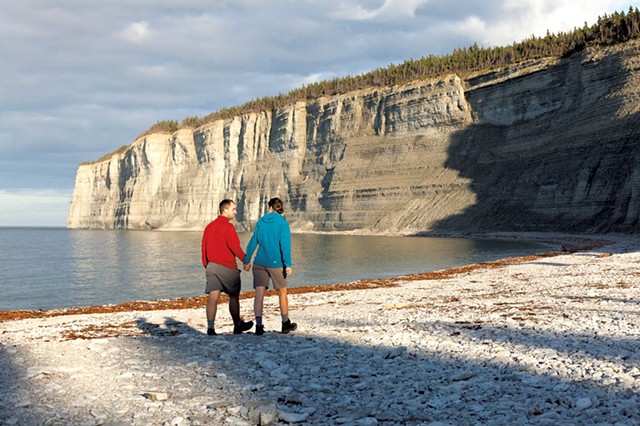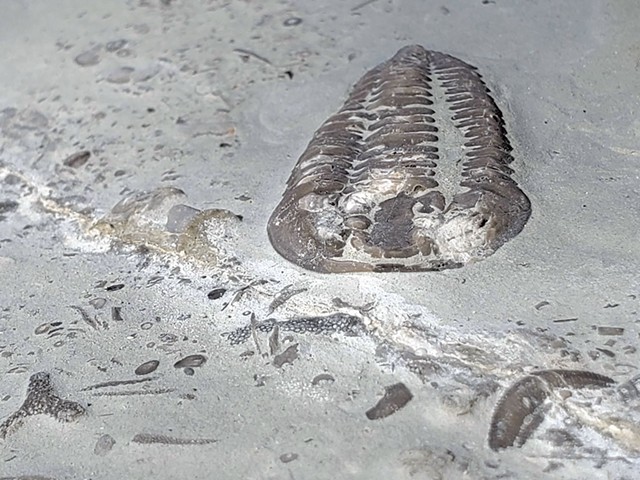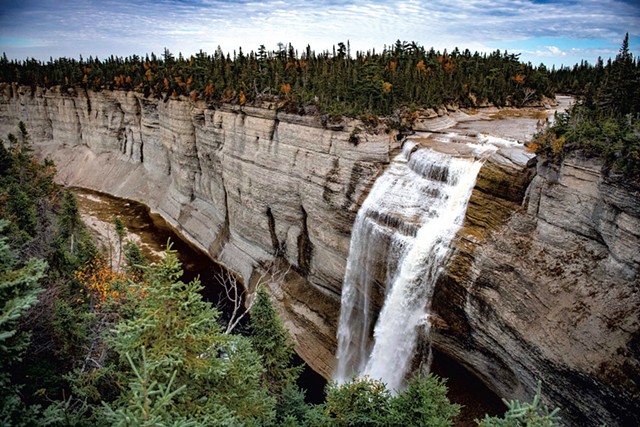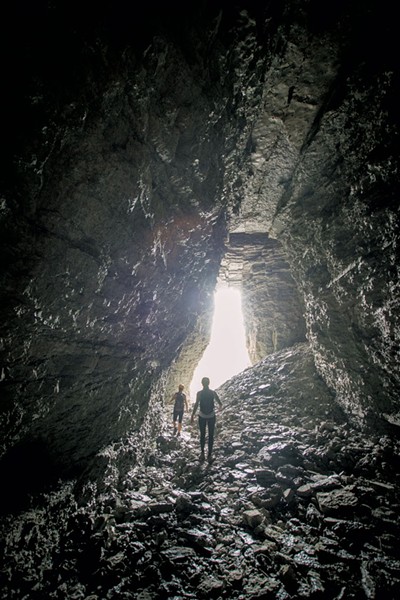
- Courtesy of SEPAQ
- Baie de la Tour
It's not precisely true that no one goes to Anticosti Island, the windswept and shipwreck-ringed shard of land that sits where the St. Lawrence River meets the sea. There are the island's 200-odd year-round residents, for starters. Hunters travel there each fall in hopes of bagging the abundant white-tailed deer that browse its boreal forests; I've dreamed of going for ages.
And so, after the 3,047-square-mile island was named a UNESCO geopark last year, a designation that recognizes sites of extraordinary geological value around the world, I surveyed Vermont geologists, sure I'd find one who'd made a trip to see the pristine fossils crowding Anticosti's seaside cliffs, river valleys and headlands. Even among our state's professional rock hounds, however, the island seems to remain tantalizingly out of reach.
"Alas, I have not been to Anticosti Island. It does sound fascinating," wrote Raymond Coish, emeritus professor of geosciences at Middlebury College, in an email. Middlebury assistant professor Alexis Mychajliw, a National Geographic explorer who trained as a paleontologist and studies global extinctions, was even more concise: "I WISH!"
Just 1,000 people visited Anticosti Island last year, estimates Suzie Loiselle of the regional tourism organization Le Québec Maritime. It's a landscape unmarred by mass tourism, or even the minor kind. The only way to get to Anticosti is via seasonal flights from extremely small airports in Québec, or — even slower but far more romantic — aboard the Bella Desgagnés, a freighter ferry that plies far-flung ports along the St. Lawrence River.
One scientist who does research there mused that Anticosti Island may be among the most isolated places in eastern North America. But for Vermonters, it's also just right there; not impossibly remote, merely inconvenient. And travelers willing to make the journey earn access to one of the most adventurous destinations in southern Québec, where a fascinating history is written into the ground beneath their feet.

- Courtesy Of Joshua Zimmt
- A trilobite fossil in the Becscie Formation
"The entire island consists of ancient seafloor sediments deposited between 447 and 434 million years ago," said Joshua Zimmt, a stratigraphic paleobiologist and postdoctoral fellow at McGill University who has conducted several fieldwork seasons on the island. Zimmt explained that, for scientists, Anticosti Island is the best place in the world to study the Late Ordovician mass extinction, the first of our planet's five big die-offs, which wiped out some 80 percent of life around the world roughly 450 million years ago. "You can find anything you can imagine, in terms of the fossil record of that time, just lying on the surface of the island," he said.
You don't need to be a specialist — only to look around you. Trilobites with spindly legs bug out of sheer walls; hornlike, whorled coral bristles from stone. "You're literally walking on fossils, almost every step you take," said Julie Ouimet, co-owner of Anticosti Ecotours, who moved to the island after falling in love with its wild landscape during a 2020 visit. "As soon as you get out of town and start driving around, the sheer beauty of the place just takes your breath away."
Some highlights from that history are on display at the Anticosti History, Culture and Paleontology Interpretation Center in the island's main town of Port-Menier, where an exhibition covers the basics of the extinction event preserved in Anticosti fossils. But most Anticosti Island fossils remain in place, exposed in eroded sedimentary rocks overlooking river valleys and empty beaches.

- Courtesy Of Sébastien St-jean/tourisme Côte-nord
- Vauréal Falls
Fossil sites line the roughly 80 miles of hiking trails within Anticosti National Park, run by Société des établissements de plein air du Québec (SEPAQ). Among the most popular is the 4.3-mile round-trip walk to 250-foot high Vauréal Falls, following a riverbed flanked by a soaring canyon whose walls climb to 295 feet. More than 600 fossils have been identified within Vauréal Canyon; every vertical meter of its rock walls accounts for 15,000 years of marine deposits. The three-mile Les Télégraphes loop leads to Baie de la Tour, a sweeping beach framed by limestone cliffs. Rent a helmet and headlamp at the visitor center before venturing into the Grotte à la Patate (Potato Cave), among the longest caves in Québec.
For the intrepid, options abound — in recent years, travelers have blazed bikepacking routes around the island's gravel roads and recorded long-distance kayaking voyages along hundreds of miles of coastline. A few outfitters, including Safari Anticosti and Anticosti Ecotours offer guided tours of the island, with activities such as sea kayaking, hiking and wildlife watching.

- Courtesy of SEPAQ
- Grotte à la Patate
Ouimet and her partner, Michel Labrecque, lead snorkeling and scuba diving trips exploring Anticosti's barrier reef, where you can spot remains of some of the estimated 400 ships that have sunk in the waters surrounding the island. "You go to places where you have the feeling that you are the first one to be there," Ouimet said.
And there's always deer season; SEPAQ says Anticosti Island has among the highest concentrations of white-tailed deer in North America. The animals have proliferated since Henri Menier, a Frenchman who once owned the island, introduced them at the end of the 19th century. Nonresident hunting permits are sold on the island for CA$448.70, with a limit of two deer per visit during deer season, which generally stretches from early September to late November or mid-December.
The closest I've come to my own long-imagined Anticosti trip was last winter, when a friend in Richmond prepared a solstice dinner of venison — bounty from the island's hunting season.
Fork-tender to its crisp edges, the loin was aromatic, garlicky. Conjuring Anticosti's forest depths, its lonely beaches, I thought of the flavor they might impart to a wintry meal in faraway Vermont. Did I only imagine the faint brine of a northern sea?
If You Go

- Courtesy Of Mathieu Dupuis/Le Québec Maritime
- The Bella Desgagnés ferry
Flights to Anticosti Island's Port-Menier Airport (YPN) depart Sept-Îles (YVZ) and Havre-St-Pierre (YGV). Heading downstream on the St. Lawrence River, the Bella Desgagnés ferry operated by Relais Nordik (relaisnordik.com) departs Rimouski each Monday night, stops at Sept-Îles, then arrives in Port-Menier on Tuesday night (CA$208); the one-way journey from Sept-Îles costs CA$111. If you want to take the boat both ways, Bella Desgagnés passes back through Port-Menier on Sundays for arrival in Rimouski early on Monday morning.
There are a handful of seasonal restaurants, accommodations and campgrounds on the island. Painted bright purple and with its own on-site smokehouse, the Gite du Copaco (giteducopaco.com, from CA$115 per person with breakfast) offers simple rooms, high-speed internet and cell service. From June 1 to September 10, the municipality allows camping in five sites at the Pointe du Château area (418-535-0250) that's 1.2 miles outside the village of Port-Menier. Find more information at tourismeanticosti.ca and quebecmaritime.ca.







Comments
Comments are closed.
From 2014-2020, Seven Days allowed readers to comment on all stories posted on our website. While we've appreciated the suggestions and insights, right now Seven Days is prioritizing our core mission — producing high-quality, responsible local journalism — over moderating online debates between readers.
To criticize, correct or praise our reporting, please send us a letter to the editor or send us a tip. We’ll check it out and report the results.
Online comments may return when we have better tech tools for managing them. Thanks for reading.